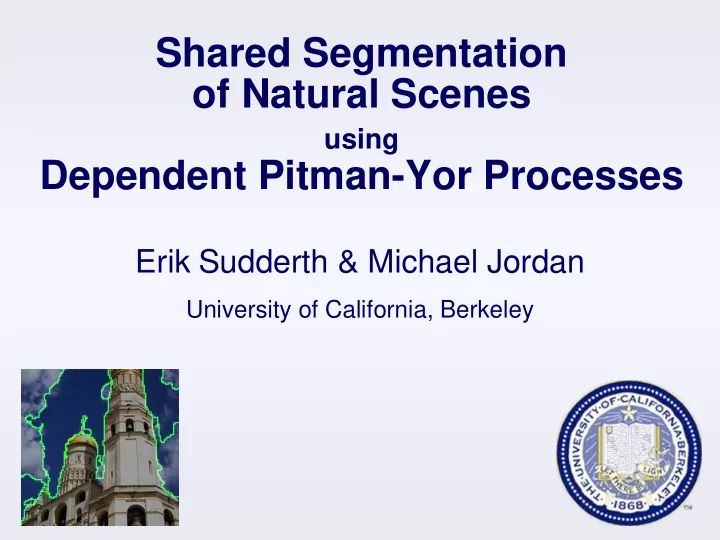

Shared Segmentation of Natural Scenes using Dependent Pitman-Yor Processes Erik Sudderth & Michael Jordan University of California, Berkeley
bell dome Parsing Visual Scenes temple sky skyscraper trees buildings sky
Are Images Bags of Features? Inspired by the successes of topic models for text data, some have proposed learning from local image features
Are Images Bags of Features? Inspired by the successes of topic models for text data, some have proposed learning from local image features Compute color & texture descriptors for each superpixel First Approach: Fei-Fei & Perona 2005, Sivic et. al. 2005 • Ignore spatial structure entirely (bag of “ visual words ”) Second Approach: Russell et. al. 2006, Todorovic & Ahuja 2007 • Cluster features via one or more bottom-up segmentations
Segmentation: Mean Shift EDISON: Comaniciu & Meer, 2002 • Cluster by modes of appearance features • Often sensitive to bandwidth parameter
Segmentation: Normalized Cuts Shi & Malik 2000; Fowlkes, Martin, & Malik 2003 • Implicit bias towards equal-sized regions • Is this a good model for real scenes?
Segmentation: New Approach Spatially Dependent Pitman-Yor Processes • Automatically infers the number of segments • Handles regions of widely varying size and appearance • Statistical framework for discovering shared categories
Outline Natural Scene Statistics � Counts, partitions, and power laws � Hierarchical Pitman-Yor processes Spatial Priors for Image Partitions � What’s wrong with Potts models? � Spatial dependence via Gaussian processes Unsupervised Image Analysis � Image segmentation � Visual category discovery
Priors on Counts & Partitions Segmentation as Partitioning • How many regions does this image contain? • What are the sizes of these regions? Unsupervised Object Category Discovery • How many object categories have I observed? • How frequently does each category appear?
Pitman-Yor Processes The Pitman-Yor process defines a distribution on infinite discrete measures, or partitions 0 1 Dirichlet process:
Why Pitman-Yor? Generalizing the Dirichlet Process � Distribution on partitions leads to a generalized Chinese restaurant process � Special cases arise as excursion lengths for Markov chains, Brownian motions, … Pow er Law Distributions Jim Pitman DP PY Number of unique clusters in N observations Size of sorted cluster weight k Natural Language Goldwater, Griffiths, & Johnson, 2005 Marc Yor Teh, 2006 Statistics
Natural Scene Statistics • Does Pitman-Yor prior match human segmentation? • How do statistics vary across scene categories? Opencountry Coast Forest Mountain Tallbuilding Highway Insidecity Street Oliva & Torralba, 2001
Labels for more than 29,000 segments in 2,688 images of natural scenes Manual Image Segmentation
Object Sizes and Counts Small Objects Large Objects insidecity region counts insidecity region areas
insidecity scenes Object Name Frequencies wheelbarrow lichen rainbow forest scenes person sky waterfall trees
Hierarchical Pitman-Yor Model Set of segments or layers Pitman-Yor prior: Pitman-Yor prior: label frequencies segment sizes No supervision aside from Pitman-Yor hyperparameters Set of global, shared visual categories Set of features in image j Set of images (superpixel color & texture) Hierarchical DP: Teh et. al. 2004 Hierarchical PY N-gram: Teh 2006
Bag of Features Segmentation LabelMe Segments:
Outline Natural Scene Statistics � Counts, partitions, and power laws � Hierarchical Pitman-Yor processes Spatial Priors for Image Partitions � What’s wrong with Potts models? � Spatial dependence via Gaussian processes Unsupervised Image Analysis � Image segmentation � Visual category discovery
Discrete Markov Random Fields Ising and Potts Models Previous Applications GrabCut: Rother, • Interactive foreground segmentation Kolmogorov, & Blake 2004 • Supervised training for known categories …but very little success at segmentation of unconstrained natural scenes. Verbeek & Triggs, 2007
10-State Potts Samples States sorted by size: largest in blue, smallest in red
1996 IEEE DSP Workshop number of edges on which giant states take same value cluster natural edge strength images Even within the phase very noisy transition region, samples lack the size distribution and spatial coherence of real image segments
Geman & Geman, 1984 128 x128 grid 8 nearest neighbor edges K = 5 states Potts potentials: 200 Iterations 10,000 Iterations
Spatially Dependent Pitman-Yor • Cut random surfaces (samples from a GP) with thresholds (as in Level Set Methods) • Assign each pixel to the first surface which exceeds threshold (as in Layered Models) Duan, Guindani, & Gelfand, Generalized Spatial DP, 2007
Assignments Segment size Non-Markov Spatially Dependent Pitman-Yor Processes: Gaussian PY prior: Feature Normal CDF
Preservation of PY Marginals Why Ordered Layer Assignments? Random Thresholds Stick Size Prior
Samples from Spatial Prior Comparison: Potts Markov Random Field
Learning & Inference GP Covariance probability that features at locations are in the same segment � Bag of features: � Image distance � Intervening countours UC Berkeley Pb boundary detector Mean Field Variational Inference � Factorized Gaussian posteriors on thresholds & eigenvector expansion of dense covariance � Jointly optimize surface & threshold via conjugate gradient � Initialize by annealing to reduce local optima
Outline Natural Scene Statistics � Counts, partitions, and power laws � Hierarchical Pitman-Yor processes Spatial Priors for Image Partitions � What’s wrong with Potts models? � Spatial dependence via Gaussian processes Unsupervised Image Analysis � Image segmentation � Visual category discovery
Tallbuilding Segments: PY-Edge LabelMe Segments:
Mountain Segments: PY-Edge LabelMe Segments:
Mountain Baseline: NCuts LabelMe Segments:
Visual Categories: Coast
Visual Categories: Tallbuilding
Challenge: Structured Objects LabelMe Segments:
Conclusions Dependent Pitman-Yor Processes allow… � efficient variational parsing of scenes into unknown numbers of segments � empirically justified power law priors � learning of shared appearance models from related images & scenes Future Directions � parallelized, scalable learning from extremely large image databases � nonparametric models of dependency in other application domains
Recommend
More recommend